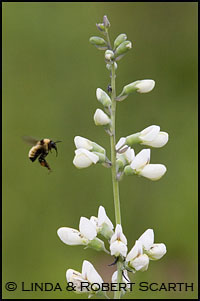introduction - galleries - technique - catalogue - notes - links - contact - blog - deep nature

Bumble Bee & Wild Indigo
The news media is full of speculation about the state of honey bees and native bees in our quickly changing climate and environment. Bees (and other pollinators) are an essential part of the food and reproductive chains of all terrestrial creatures on earth, including humans. Agriculture requires pollinators for human and animal food. Wild nature requires bees also. Humans, wild and domestic animals, birds, reptiles and insects all require plants to survive.
The gravity of this situation was made even more apparent to us the first weekend in May this year when we participated in an art festival in a large, beautiful, blooming botanical garden. The air was so perfumed from flowering trees that someone suggested bottling it. Another artist joked that he bet Linda could not capture the scent as she was photographing one of the profusely blooming trees. She commented that there were no honey bees or other bees when the garden should be full of them, drawn by the perfumes. He speculated about possible causes for the large decline in bees and wondered about the recently reported interference of radio waves from cell phone towers.
We only saw a lone bumble-bee the whole day in the garden. No butterflies, no bees, no flying insects; only the ants who found an apple core and those wandering through a patch of Wild Ginger. The garden has an enormous collection of horticultural and native species ? many of which need bee pollinators. In our own garden this spring we have seen one bumble-bee, one small native bee and one possible honey bee. Not only are bees not finding their ways home to their hives as mentioned in news and scientific stories; they are not finding their way here. The flowering crab had fewer blossoms because of the frost after the heat wave in March. With no bees, it is unlikely to have much fruit to attract the Cedar Waxwings in late autumn.
Among the possible contributing factors to what is called Colony Collapse Disorder are viruses, fungi, mites, other parasites, pesticides and other chemicals, toxic pollen or nectar, lack of food, and weather conditions (climate change). Some beekeepers and scientists believe there may be combinations of causes though there is growing evidence that it may be a fungus, at least in some areas of the country. One of the features of climate change is that fungi and other organisms change their habits and locations and ability to impact the environment. Other names for the bee condition are ?dwindling disease? and ?disappearing disease.? The striking feature is that bees leave their hives and do not return, rather than die in or near the hive. The bee population becomes so diminished that the honey stays in the hives untouched by other bees that would ordinarily salvage it.
Bees are interesting photographic subjects as well as essential partners in feeding us all. They are large enough to track through a lens. They display differing temperaments. They are certainly busy and productive. And they are especially beautiful; particularly the small native iridescent green bees that wear their bright yellow pollen chaps with such aplomb. It is no wonder that a number of other insects try to camouflage themselves as bees.
One of the few times we use full flash or photograph in direct sunlight is when we photograph bees and other insects. The direct light is best early or late in the day ? often golden and warm. The light can be worked with at other times if there are few reflective surfaces in the frame. Sometimes on early mornings we find bumble bees that have spent the night hanging under Bee Balm (Monarda fistulosa) blossoms as they slowly wake and warm to crawl topside for breakfast as nectar starts to flow ? a classic bee?s bed and breakfast.
When bumble bees visit the little strip of prairie plants by our back door, Bob likes to take a small branch of feathery yarrow leaves and gently stroke them when they are busy on a blossom. Sometimes they will lift a hind leg and scratch the air much like a dog who is enjoying a good rub on its side or back. Other bee species do not take kindly to this activity. Several years ago our daughter presented Bob with a t-shirt with ?Bumble Bee Charmer? printed on it. He wears it with pride.
? Linda & Robert Scarth, 2007.
First published in NatureScape News, 2 (6), 6, 2007.
